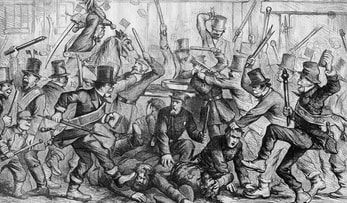
Boston was a major center for immigration in the 19th century due to its large seaport. Nativist and anti-Catholic sentiment was strong, especially among working-class men whose jobs and wages were threatened by an influx of poor Irish immigrants. On Broad Street, it was common for groups of nativist Yankees to vandalize Irish homes and attack lone Irishmen. In 1832, Mayor Charles Wells received a petition "praying that some measures may be taken to suppress the dangerous riots, routs, and tumultuous assemblies in and about Broad Street."
At the time of this particular riot, nearly all of Boston's firefighters were volunteers. The city had a policy of paying whichever company was first to arrive on the scene. As a result, the volunteer fire companies were intensely competitive, as well as notoriously undisciplined, and often fought with each other. In 1834 the entire company attached to Engine 13 was dismissed for disorderly conduct. The volunteers were nearly all working-class "Yankees", meaning American-born Protestants. Boston also had no police department, only a City Marshal with a small number of night watchmen.
The June 11 riot started when a group of Yankee firefighters who were ending their shift encountered a large procession of Irish heading to a funeral. One of the Yankees, who was reportedly drunk, shoved on of the Irish and a general melee ensued. Although no immediate deaths resulted from the violence, a Yankee fireman was knocked unconscious, and false reports of his death caused the rioting to escalate. A local paper announced the following Monday, "There have been many battered and broken heads, and many bodily bruises; but we are inclined to believe there has been no actual loss of life."
 RSS Feed
RSS Feed